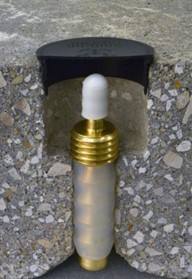 The Vapor Pin® is ideally suited for locating Volatile Organic Compound (VOC) contamination sources beneath pavement or concrete surfaces. A common experience is that many sites have sources of contamination in addition to those associated with underground tanks and degreasing areas. Unsuspected source areas often correspond to former exterior doors that were obscured by later building expansion.
The Vapor Pin® is ideally suited for locating Volatile Organic Compound (VOC) contamination sources beneath pavement or concrete surfaces. A common experience is that many sites have sources of contamination in addition to those associated with underground tanks and degreasing areas. Unsuspected source areas often correspond to former exterior doors that were obscured by later building expansion.
Cox-Colvin has located such sources equipped with little more than some Vapor Pins®, a hammer drill, and a multi-gas meter. Cox-Colvin’s approach to VOC source investigation consists of installing Vapor Pins® along a grid, allowing the points to equilibrate, and collecting readings with a multi-gas meter. With a team of two people, Cox Colvin has installed as many as 90 Vapor Pins® in one day, taken samples, removed the Vapor Pins®, and plugged the holes on the following day. In Australia, HydroTerra can assist with your installation and removal requirements. We have trained resources available to carry out this task.
Some common questions:
Can the Vapor Pin® sampling device be used in slabs of any thickness?
The Vapor Pin® sampling device is designed to be used in slabs that are at least three inches thick. If the Vapor Pin® sampling device is installed as a flush mount, we suggest that the slab be at least four inches thick. Because the Vapor Pin® sampling device does not have to extend to the bottom of the slab, there is no maximum slab thickness, provided your drill bit is long enough to drill into the sub-slab. A 5/8-inch drill bit with a length of 24 inches covers most situations.
Can I leave a Vapor Pin® sampling device in place between sampling events?
Yes. The Vapor Pin® sampling device can stay in place as long as necessary. For repeated use, we recommend a flush mount installation using a stainless-steel Vapor Pin® sampling device to protect the pin from damage and corrosion. Keep in mind that the flush mount cap is not watertight and should not remain in place in areas subject to contaminant spills. If future sampling is not required, the Vapor Pin® sampling device should be removed and the hole in the slab filled with hydraulic cement.
Does the Vapor Pin® sampling device provide a tight seal against the slab?
Under normal circumstances, with proper installation through a concrete slab, the Vapor Pin® sampling device provides an air-tight seal. Cox-Colvin has leak tested the Vapor Pin® sampling device with helium; with 99% helium in the leak-test shroud, no helium (<50 ppm) was detected in soil gas. In some situations, such as a thin concrete slab, cracked and degraded concrete, or a hole greater than 5/8-inch diameter, a poor seal may result. We recommend leak testing as part of the sampling procedure.
Is there a way to attach a piece of tubing, a filter, or other accessories to the bottom of the Vapor Pin® sampling device?
Vapor Pin® Sampling Devices are manufactured with a female thread at the bottom specifically for attaching a barbed adapter, available from HydroTerra. The barbed adapter allows you to attach tubing to the bottom of the Vapor Pin® Sampling Device to increase sample depth, to add a particulate filter such as an aquarium bubbler, etc. The barbed adapter has the same size barb as on the top of the Vapor Pin® Sampling Device and fits the same tubing.
You can also increase the sample depth with the Vapor Pin® Extension, which screws into the bottom of the Vapor Pin® Sampling Device. The extension has male threads at the top and female threads at the bottom, allowing you to screw them together and extend the sample depth as much as desired in 1.5-inch increments.
Overall, the Vapor Pin is a great tool for sub-slab Volatile Organic Compound (VOC) site characterization. Please call HydroTerra today for further details. Ph: +61 (3) 8683 0091.






